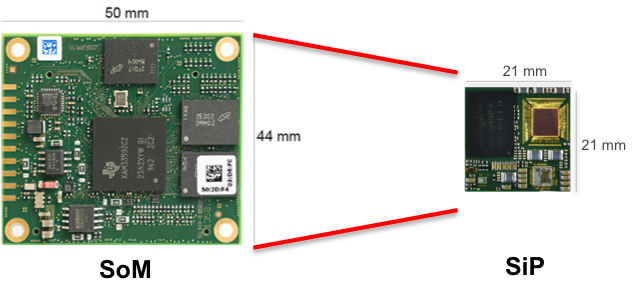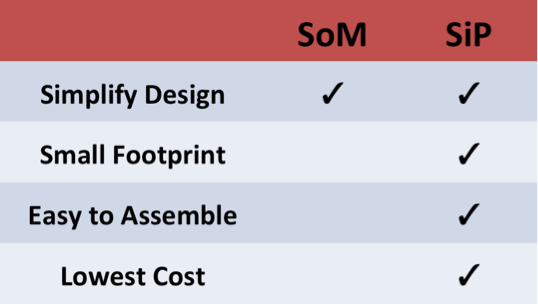
Greg Sheridan
Marketing Manager
Posted on February, 22, 2018
Categories
Recent Posts
- Octavo Systems Unveils the OSD32MP2 Series: Revolutionizing System Design in the Electronics Industry April 9, 2024
- Securing the Future: The Integral Role of SiP Technology in Thwarting Physical Attack Vectors in Embedded Systems March 12, 2024
- Developing Secure Embedded Systems: Best Practices and Strategies March 12, 2024
- Heterogeneous Integration (HI) and System-in-Package (SiP) Technology: A Comprehensive Overview February 20, 2024
- Understanding The Differences Between System-on-Chip (SoC), Package-on-Package (PoP), System-on-Module (SoM), and System-in-Package (SiP) January 17, 2024
SiP vs SoM: What is the Difference?

When we introduce new customers to our System-In-Package (SiP) solutions they often ask how a SiP is different from a System-On-Module (SoM). Fact is, in functionality, they are very similar. The two solutions address similar design challenges and provide similar value, however, they do this in very different ways.
Solving Problems
Both SiPs and SoMs aim to simplify the design process by abstracting away many of the tedious tasks that slow down the development of an embedded system. They both accomplish this by taking key components and putting them together into a ready to use system. All you need to do is drop them into a design and move on to the rest of the system. You don’t need to spend any time worrying about things like power sequencing or DDR routing. These are done for you on the SiP or SoM.
The Divergence
Where SiPs and SoMs differ is in how they actually solve these problems. SoMs are essentially small Printed Circuit Boards (PCBs) that are attached to your final PCB. SoMs utilize the same techniques and processes that are used in any PCB design and manufacturing process. They use discrete packaged components, the same schematic and layout techniques, and the same pick and place and reflow process that any other PCB would go through. This makes SoM solutions bulky, pricey, and hard to attach to a final board.
SiPs on the other hand bring together primarily bare silicon die and attach it to a substrate leveraging technology that is used by the semiconductor industry. This allows a SiP to look like just another standard IC component instead of a PCB. Leveraging Silicon Manufacturing techniques also enables SiPs to be much smaller, more cost effective, and a breeze to manufacture with.
Example
Costs
Take a look at the OSD3358-512M-BSM and an equivalent SoM from a leading provider. Build equivalent systems around both. The SiP based system will cost approximately $31 while the SoM based system would cost approximately $48. This is a 54% price increase for a SoM based system over a SiP based system.
Next let’s look at the manufacturing cost delta when adding these solutions to your board. A SoM is a PCB that needs to be attached to your board with a special connector. The connectors for the SoM used in this analysis cost $8. These expensive connectors are required for the highspeed data lines that go on and off the SoM like USB and Ethernet.
Beyond the cost of the connectors, installing the SoM adds another step to the assembly process. Often the SoM must be applied on a special line by hand in the assembly process. This increases cost even further and introduces more points where failures can occur.
SiPs however, look and act like standard IC packages and can be connected to your PCB the same way as any other IC component. The OSD3358-512M-BSM comes in a standard BGA package. This means it can be connected to your PCB in the same mass production way as any component. There is no need for expensive connectors or special installation processes. They can go through the pick and place process with the rest of your components and can be reflowed.
Size
Continuing with the example above let’s look at how the OSD3358-512M-BSM compares in the size to the equivalent SoM. As a SiP, the OSD3358-512M-BSM benefits from using Die instead of packaged parts. Die can be up to 70% smaller than the same part fully packaged, translating into significant space savings. The SoM in our example occupies 2200mm2. The OSD3358-512M-BSM uses bare die for 3 components which allows it to only occupy 441mm2, or an 80% reduction in area.
Conclusion
SiPs and SoMs are like cousins. They aim to make designing electronic systems easier. They both abstract away common discreet subsystems that add little value to an end product but require a lot of time to implement. SiPs just do this in a smaller, lower cost, easier to manufacture package!
Contact us for a design consultation and find out how your design using SoM can benefit from a SiP solution.

